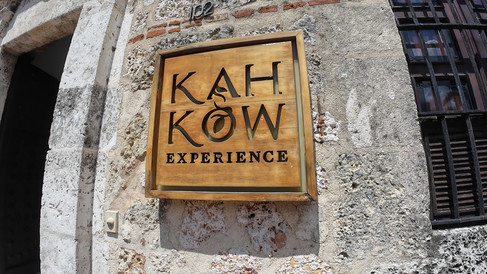Santo Domingo's Colonial Zone: A Journey Through History
- Christopher Simonson
- May 16
- 5 min read
Updated: Jun 15
Welcome to another adventure with The Adventures of Simo! Today, we're exploring the historic heart of the Dominican Republic - the Colonial Zone of Santo Domingo.
The First City of the Americas
Walking through the cobblestone streets of Santo Domingo's Colonial Zone feels like stepping back in time. Established in 1498 by Bartholomew Columbus (brother of Christopher Columbus), this UNESCO World Heritage Site holds the distinction of being the oldest European settlement in the Americas. The original city, called Nueva Isabella, was relocated to the west bank of the Ozama River in 1502 by Nicolás de Ovando and renamed Santo Domingo, becoming the template for nearly all future colonial towns in the Americas.
Cathedral of Santa María la Menor
My journey began at the magnificent Cathedral of Santa María la Menor, which dominates the main park area. This architectural marvel, built between 1512 and 1540, holds the title of the first cathedral in the Americas. Its golden-tinted coral limestone façade features a mix of Gothic and Baroque elements, with intricate carvings that have withstood the test of time.

Inside, the cathedral's vaulted ceilings and chapels house religious artifacts and artwork spanning centuries. The most fascinating aspect is how the building has been continuously used for worship for over 500 years, making it not just a monument but a living piece of history.
Parque Colón and Columbus Statue

The heart of the Colonial Zone is Parque Colón (Columbus Park), where a prominent statue of Christopher Columbus stands. The bronze monument depicts Columbus pointing outward, symbolizing the explorer's vision of new horizons. The park has been the social center of Santo Domingo since colonial times, serving as a gathering place for locals and visitors alike.
Surrounding the park are colorful colonial buildings housing cafés, restaurants, and shops where you can sit and absorb the vibrant atmosphere while imagining the historical figures who once walked these grounds.
Sweet History: Kah Kow Chocolate Tour
One of the highlights of my visit was the Kah Kow Chocolate tour, where I learned about the deep connections between the Dominican Republic and cacao. The island was one of the first places where Europeans encountered chocolate, which the indigenous Taíno people had been cultivating long before Columbus arrived.
During the tour, I had the opportunity to make my own chocolate. The process was simple as most of the leg work was already done but fun either way.
Fortaleza Ozama: Guarding the City

A short walk from the cathedral brought me to Fortaleza Ozama (Ozama Fort), the oldest formal military construction of European origin in the Americas. Built in 1502, this imposing stone fortress guarded the entrance to the city from the Ozama River. Its strategic position allowed Spanish authorities to control maritime traffic and defend against pirate attacks that were common in the Caribbean during the colonial era.
The fort's dungeons, barracks, and parade grounds provide a glimpse into military life during colonial times and the complex power dynamics of Spain's empire in the New World.
Strolling Down Calle El Conde
My exploration continued along Calle El Conde, the famous pedestrian street that runs through the heart of the Colonial Zone. Named after the Count of Peñalva, who governed the island in the 17th century, this vibrant thoroughfare connects Plaza España to Parque Independencia.

The street is lined with colonial-era buildings painted in bright Caribbean colors, now housing boutiques, art galleries, and cafés. Street performers and artists add to the lively atmosphere, making it the perfect place to experience local culture. The blend of historical architecture and modern commerce creates a unique environment where past and present coexist harmoniously.
Culinary Delights at La Marchanta
No travel experience is complete without sampling the local cuisine, and my meal at La Marchanta Restaurant did not disappoint. This charming eatery serves traditional Dominican dishes with a contemporary twist.
I enjoyed a classic Dominican plate consisting of white rice, a fresh salad, and tender meat – a simple but satisfying combination that showcases the country's staple ingredients and cooking techniques.

Dominican cuisine reflects the island's diverse cultural influences – indigenous Taíno ingredients like cassava and sweet potatoes, Spanish cooking techniques, and African flavors all merge to create distinctive dishes that tell the story of the island's complex history through food.
Ruinas de San Nicolás de Bari: Echoes of the Past
One of the most intriguing sites I visited was the Ruinas de San Nicolás de Bari. These ruins of what was once the first hospital in the Americas were built around 1503. The structure, commissioned by Governor Nicolás de Ovando, was designed to care for the Spanish settlers who fell ill in the unfamiliar tropical climate.

Today, only stone walls remain, creating hauntingly beautiful arches against the sky. Walking through these ruins, I couldn't help but reflect on the human stories that unfolded here – the doctors who practiced early medicine, the patients who sought relief, and the complex society that built institutions mirroring those in Spain while adapting to a new environment.
Iglesia de Nuestra Señora de la Altagracia
Another architectural gem I explored was the Iglesia de Nuestra Señora de la Altagracia. This church holds special significance in Dominican religious culture, as the Virgin of Altagracia is the spiritual protector of the Dominican people. The church's simple yet elegant façade belies the spiritual importance it holds for locals.

The original image of the Virgin was brought from Spain in the early 16th century, and devotion to her quickly spread throughout the island. The church serves as a reminder of how Catholicism became deeply interwoven with Dominican identity during the colonial period.
The Colorful Streets: A Photographer's Dream
Perhaps what captivated me most about the Colonial Zone were the colorful streets lined with buildings in vibrant hues of blue, yellow, pink, and green. These colors aren't just decorative – they speak to the Caribbean aesthetic that developed as European architectural styles adapted to the tropical environment and local tastes.

Many buildings feature traditional elements like wooden balconies, interior courtyards, and ornate ironwork that showcase the craftsmanship of colonial artisans. Despite centuries of hurricanes, earthquakes, and political upheavals, these structures stand as testaments to durable building techniques and ongoing preservation efforts.
Reflections on History
As I concluded my exploration of Santo Domingo's Colonial Zone, I found myself contemplating the layers of history embedded in these streets. This district witnessed the beginning of European colonization in the Americas, with all its complexity – the cultural exchanges, technological innovations, and human suffering that shaped the modern Western Hemisphere.
The Colonial Zone isn't just a collection of old buildings; it's a living museum where contemporary Dominican life unfolds against a backdrop of 500 years of history. It reminds us that the past isn't distant – it's the foundation upon which our present stands.
If you're planning to visit the Dominican Republic, I highly recommend spending at least two full days exploring the Colonial Zone. Beyond the sites I've mentioned, there are dozens of museums, churches, and historical buildings worth discovering, each with its own story to tell.














